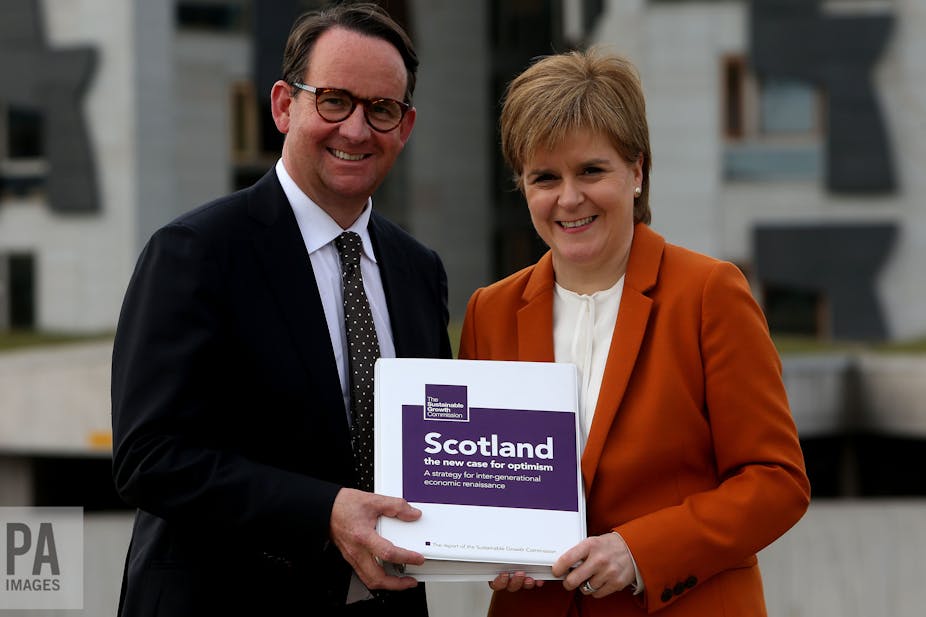An SNP-commissioned report declares that independence could boost economic growth and make Scots £4,100 richer per year. Unionist parties rubbish the claims. Economists emphasise the uncertainty around such forecasts but are ignored. The keyboard armies resume their online crossfire. In newsroom terms, the latest developments in the Scottish independence debate are all very “dog bites man”.
The SNP has high hopes that its Growth Commission report will bring fresh momentum to the campaign for another referendum on Scottish independence. But is there good reason to suppose that it will have much impact on the wider public – and, in turn, on the likely timing and outcome of “Indyref 2”?
Not really.
Some of the reasons for this are obvious. A large proportion of the Scottish electorate is immovable on the issue of independence. Some of the rest could be swayed – but not by a report from the SNP, either because they distrust the party in general or because of its obvious partiality on the issue of independence. And most of those who are open to an SNP message about the economic benefits of independence have presumably already been swayed, unless they somehow managed to miss the two-year campaign for Indyref 1.
Voters crave certainty
There are also two deeper reasons. Both have to do with the role the economy played in 2014 – and would play in a potential rerun. The first is that it may well have been uncertainty more than pessimism that cost Yes in the Independence referendum. Consider the graph below, which is based on data from the Scottish Referendum Study and the British Election Study internet panel. The left-hand side shows that, while pessimists outnumbered optimists when it came to economic expectations in 2014, the gap was not huge – and barely different from the case of Brexit two years later.
Plainly it is possible to win a referendum from such a position. The big difference between the two cases is on the right-hand side and, specifically, the far larger proportion of voters who were “very unsure” about the impact of Scottish independence.

So what will make voters more sure? The SNP report’s proposal to keep the pound for at least ten years after independence will help. It’s hard to imagine any forecast of prosperity having much impact, though – especially if, as usually happens, it is swiftly followed by a conflicting forecast. While the partisan will accept or reject these predictions as per their existing views, each new forecast probably only deepens the uncertainty of the wavering voter.
All of this makes it more difficult to believe that the Yes surge in the final months of the 2014 campaign was due to persuading longstanding sceptics that the Scottish economy would thrive under independence. True, those who switched to Yes were more likely also to become more optimistic about the economics of independence, but that optimism might easily be a byproduct of a switch made for other reasons. Once they have chosen an option, voters are then prone to see all its aspects in a more favourable light.
Dividing the pie
What else might have caused the switch to Yes, then? This brings us to the second deeper reason to question the impact of a report like this. The Growth Commission is all about the size of Scotland’s economic pie. Arguably, the independence surge had more to do with how that pie would be divided up. In a campaign that perceptibly reddened in its final weeks, the primary Yes goal often seemed to be persuading voters that an independent Scotland would be more equal and more redistributive.
There are various signs that this ideological appeal was influential – and more so than any boost to the general macroeconomic credibility of independence. One is that switchers to Yes came very disproportionately from parties on the left (mainly, of course, Labour) and were also disproportionately likely to identify as left-wing (in terms of their self-placement on an ideological scale).
Another is that, as the campaign moved into its final weeks, the relative importance of the national economy for voters’ choices declined while two other judgements became more important: whether voters thought that independence would narrow the gap between rich and poor, and whether they thought it would be good for their personal finances.
People did care, then, about how much pie they personally would get out of independence – they just knew that that was also about how it was shared out. No surprise that those in economically impoverished areas, perceiving a meagre share under current arrangements, were readier to support independence. What use is growth if the proceeds go to other people?
Few voters will be persuaded by this report, then, or indeed by the wider debate which it reopens. But is that debate at least more fertile soil for one side or the other? At first sight, it looks more like unionist territory. While pessimists outnumber optimists, a discussion of economic consequences is one in which the pro-independence camp is vulnerable. Indeed, in general it helps the No side to be talking about independence and the Yes side to be talking about the union, since the average Scottish voter is far from convinced about either.
However, even if this is favourable ground for them, unionists need to tread carefully. No one studying the 2014 campaign in the round can conclude that Project Fear was a successful strategy. Voters may have their economic doubts about independence but, as we saw again with Brexit two years later, they react against politicians hammering home that negative message. “Yes we can” is liable to beat “No we can’t”. For this reason, many swing voters will like the sound of the SNP’s latest report, even if they aren’t planning how to spend their £4,100 just yet.

